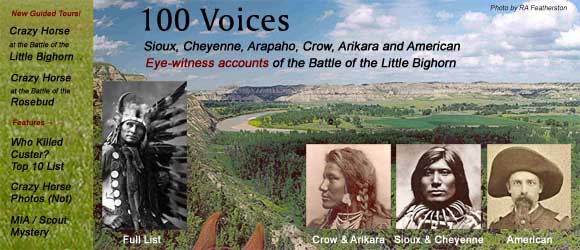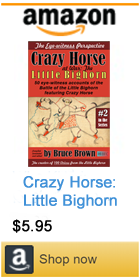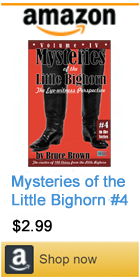|
||||||||||||
Bruce Brown's 100 Voices... Standing Bear's Story of the Battle, #1
STANDING BEAR TELLS ABOUT THE CUSTER BATTLE
The horses were across the Little Big Horn and so I ran for the horses and waded through about breast deep. I got on top the Black Butte and looked upstream. I saw soldiers beginning to charge and they were all spread out, going down a hill. They crossed the Little Big Horn and were coming up the flat (Reno's men). At this time Custer was coming around, probably. There was a bed of cactus here and it was hard to go down the hill, so I stopped and saw the troops coming down the river. I tried to find my way through this cactus in my bare feet and I could see the dust flying. Soon the dust was coming closer and closer and over on a hill in the south there I could see Custer coming the other way. Custer stopped on top of a big hill. Then I turned back to the camp without getting the horses. As they proceeded downhill I noticed that the Oglalas and Hunkpapas were fleeing and everyone was excited. I waded across the Little Big Horn again and got into the camp. We waited for the horses thinking they might bring them back. Then we could see the Indians charging close to the soldiers. There was nothing but Indians at the place. There were voices all over and everyone was saying something. It seemed that all the people's voices were on top of the village. Just then our horses were brought back and I had a gray horse and I went and caught him. One of my uncles said: "Hurry up, we shall go forth." We got ready and started and this was before the women got back. We proceeded toward Custer and we crossed at the mouth of Muskrat Creek. We were north of the Santees at this time. When we crossed the Little Big Horn you could see nothing but Indians swarming on Custer and you could hear guns going repeatedly. There was a Sioux coming back with his mouth full of blood and his horse was wounded, with blood all over him. This was a brave warrior by the name of Long Elk. This is the first thing I saw as were going up there. My party was on the west side of Custer at this time. There were some Indians ahead of us (the frontersall the braves are in the front), but where I was we called it the rear end (those not as brave). I caught a horse and tied it up. As we went on I saw another Sioux with blood in his mouth. He was very dizzy. He stood up and then began to come down again -- he was wounded. I went on further and saw a soldier lying dead, and there were Indians lying among them on this hill. I don't know how they got killed together, because I wasn't down there. When I got far enough over to see well, I noticed that the men were off their horses holding them by the bridles. They were ready for us, of course, and then they began to shoot and the bullets were just raining. The Indians were creeping up to them and the bullets went over us. All of us yelled "Hokahey!" and started charging up the hill. The next thing I saw was soldiers sitting with their hats off on this hill. Then the soldiers immediately started to shoot at us. Custer was now on a ridge and we followed the ridge there and I saw one Indian go up and shoot at the soldier and in answer the soldier began firing again. As I got up there was a Sioux on horseback behind me. He asked me who it was who had gotten shot and I told him that it was Bear Horn. I started down [hill] again and just about this time there was a man by the name of Burst Thunder who came up to us and told us to go down a little ways that there was a dead man here whom we should scalp (a Ree). So we went and just as they scalped him there were two Cheyennes that came up to us. Burst Thunder asked him if this was a Ree or a Cheyenne that we had scalped. One of the Cheyennes got off and turned the body over and found out it was a Cheyenne that they had scalped. [Note: this could have been the great Southern Cheyenne war chief Lame White Man, who was scalped by the Sioux in the frenzy of battle.] This shows how crazy everyone was at this time. Three riders appeared and they had a dead Cheyenne with them carrying him by riding abreast. As these riders went down I peeped out to where the soldiers were and they fired once more. The first time I looked there were many there and after the Indians shot at them some more, I noticed there were very few of them left on the hill (Custer's). I heard some of the men say: "They have gone!" I looked over there then and I noticed there were the cavalrymen's horses running away after breaking loose. On the north side the boys took the horses after they had stampeded. I looked out again and I saw that there were very few of them left this time. Every time I looked there were less soldiers living. There were Indians all around the hill here. Right after the stampede of the horses I heard them say: "They are gone!" and the soldiers were retreating downhill toward the Little Big Horn. Then we hollered: "Hokahey! Hurry, hurry!" Then we all went up. I could see Indians charging all around me. Then I could see the soldiers and Indians all mixed up and there were so many guns going off that I couldn't hear them. The voices seemed to be on top of the cloud. After the soldiers went toward the Little Big Horn they went into the side of a hill into a draw and there was tall grass in here. We were right on top of the soldiers and there was no use in their hiding from us. Then I saw an Indian rush at the men and then the Indians killed every soldier including some of our own Indians who had gone ahead of the rest. When we killed the last man, we could hear the women coming over and it was just a sight with men and horses mixed up together-horses on top of men and men on top of horses. After we wiped Custer out we started back in formation downhill, ten or fifteen riders abreast. At the mouth of the Muskrat Creek there was a little divide and before we crossed this creek we could see another band of soldiers here ([Lt. Edward S.] Godfrey's men) [who had come back] to help Custer. They began to fire on us then and everyone said: "Hurry!" and began to charge on them. Then they began to get on their horses as I looked out again. They retreated and I noticed two spades on the hill. When we got up there we shot at the soldiers but only got one of them. Then we all got on our horses and pursued the soldiers. After we shot one of the men we all got off and couped him. The soldiers fled and went back on Reno's Hill where they had their pack mules. Then the Indians surrounded them again and Reno's men were digging in the hill and we hollered: "Hokahey!" and began firing on them once more. After a while I could see some of them going toward the creek to get water. Then we kept shooting at them and the others turned back from the creek. On the east side there was an Indian rider going up close to the whites showing how brave he was. He was shot here and it was impossible for us to get the body. By this time it was nearly sundown. I smelled blood all over and I did not feel very hungry at first, but now I began to get hungry. The soldiers were still on the hill surrounding the pack mules. The bravest of braves got together and talked over what they were to do tonight. They decided that some would stay while the others went to get something to eat, and we did stay here all night. We couldn't get at the soldiers, so we decided we would starve or dry the soldiers out. We started back to the camp to eat and some of them stayed there. We got back at about sundown. I was still barefooted and had been all day. The weapons I had were bow and arrows and a revolver.
I was dressed thus: I was barefooted and I had on only a shirt. Before the battle I had shot a redbird and had skinned it. Indians should have a sacred ornament, and I took this bird along on my head and I vowed that I would make an offering if this bird should help me in the battle to keep from getting wounded. After the battle I heard a lot about Crazy Horse. It has been proven that it was Crazy Horse who broke Reno's left wing. Crazy Horse went through once and cut them off. After the battle I went over the battlefield. [Note: here are descriptions by Arikara scout Young Hawk and Sioux warrior Iron Hawk of Crazy Horse's first charge of the battle. For more info, see Crazy Horse At The Little Bighorn.] Where Reno had charged I noticed there was a Ree who had gotten killed there. (Down in the brush of the creek there was another Ree killed by the name of Bloody Knife.) They had retreated up a little cutoff; there was another Ree killed. Going back, I thought they had broken camp, but they hadn't. I was hungry and I ate heartily when I got back to camp. The camp pulled together in one solid mass. There was quite a lot of excitement yet, so we did not have any war dances this night. We built fires all over the camp. Then, before the next morning, I couldn't sleep, because I kept recalling the horrible things I had seen. It seemed that everyone was excited and moving around and the whole village did not sleep a wink. Next morning the criers said: "The remainder of the soldiers shall perish today." Then everyone got on their horses ready to finish the soldiers. I got on my horse and went with them. This time I was well dressed and I had my moccasins and leggings on. This time I had my saddle too-I was prepared for the fight. This was early in the morning and when we got there the watching party of Sioux went home. We surrounded the soldiers and we hollered: "Hokahey!" and [raised up and] fired at the soldiers. Some of us were on one side and others were on another side-we were scattered all around. By this time the soldiers were getting thirsty and they would crawl to the creek and try to get water. We would shoot some of them and then the followers would turn back to their trench. We were pretty well hidden from the enemy and we hid our horses so that they couldn't get hurt. They sent shots at us again and I heard one of our horses get hit. Then beside me there was an old man and this was his horse. We told him that his horse had gotten shot and this old man went over and got his horse and said that he was shot all right but that he was bullet-proof. They happened to hit the buffalo skin blanket of the saddle and the bullet bounced off of it. We looked for the bullet and found it right near the horse. We lay down back where we were. We heard someone say: "Hey, hey" meaning that one of the Indians had gotten shot. So we crawled around to this man. He had gotten shot above the eyebrow and he had been killed instantly. We kept on shooting at them but we couldn't do any harm for they were entrenched. Just about this time we heard the crier announcing that it is reported that some soldiers are coming. "We will leave this and let it go" (meaning that they would move camp). Everyone started to go back to the camp, so I joined them. If [Gen. Alfred H.] Terry hadn't come along all the soldiers would have perished that day. The Sixth Grandfather: Black Elk's Teachings Given to John G. Neihardt, edited by Raymond J. DeMalle, University of Nebraska Press, Lincoln, NE, 1985 p 180 - 184
Standing Bear was Iron Hail's brother. Here is a 1910 account of the battle by Standing Bear, another 1910 account, and an undated account, plus Standing Bear's recollection of the great Sun Dance before the battle where Sitting Bull had a vision that the bluecoat soldiers fell from the sky and all died.
|
||||||||||||




 THAT MORNING when we got up, most of the women went out to dig turnips and my uncles were out hunting. My grandmother who was very old and feeble, my uncle and I all stayed in a tipi. I went down in the river to take a swim. My hair was braided and all I had on was a shirt when I came back from the swim. My grandmother began frying some meat on the ashes of the fire. Then she fed us all. As we were eating, my uncle said: "After you are through eating you had better go and get the horses, because something might happen all at once, we never can tell." An older brother of mine and another man were out herding horses in two bunches on the Muskrat Creek downstream. Before I finished eating there seemed to be quite a lot of excitement outside. Then I heard a crier announce that the chargers were coming and there were two men who went out to look for horses and one of them got killed. When we heard this, my uncle said: "I told you before, that this would happen. You'd better go right away and get the horses."
THAT MORNING when we got up, most of the women went out to dig turnips and my uncles were out hunting. My grandmother who was very old and feeble, my uncle and I all stayed in a tipi. I went down in the river to take a swim. My hair was braided and all I had on was a shirt when I came back from the swim. My grandmother began frying some meat on the ashes of the fire. Then she fed us all. As we were eating, my uncle said: "After you are through eating you had better go and get the horses, because something might happen all at once, we never can tell." An older brother of mine and another man were out herding horses in two bunches on the Muskrat Creek downstream. Before I finished eating there seemed to be quite a lot of excitement outside. Then I heard a crier announce that the chargers were coming and there were two men who went out to look for horses and one of them got killed. When we heard this, my uncle said: "I told you before, that this would happen. You'd better go right away and get the horses."








